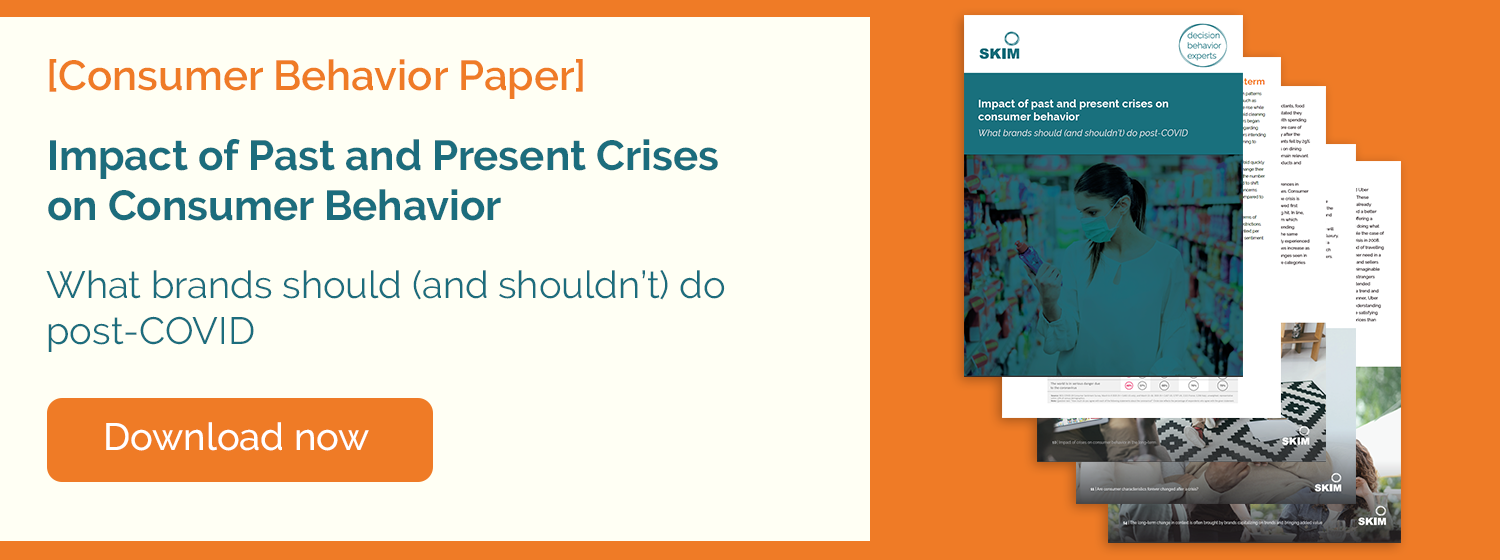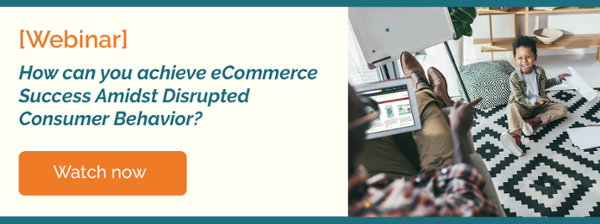COVID-19 has radically changed the context in which we make decisions, disrupting many habits. No one can predict if the behavioral shifts will last or what the recovery period will look like.
Online shopping and media consumption will undoubtedly continue to grow (as it was pre-COVID-19) … but to what degree? Will brand-loyal consumers who switched brands due to limited stock eventually return?
Six months after the disruption started, a new economic reality will settle in.
As marketers, we can still learn from the past, but extrapolating the past after a disruption isn’t wise. Instead, it’s essential to fully understand consumer decision behavior in the new reality, the new context.
This is the only way we’ll know how people will react to online channels, promotions, prices, or new alternatives on the other side of this crisis.
Whether your post COVID-19 strategy is to attract or retain customers, bear in mind what you can still control – your marketing mix (i.e. 4Ps). Ensuring these strategies are rooted in behavioral frameworks will give you a competitive edge.
Here’s what you need to know about decision behavior following disruptions and four marketing strategies to help you in the new economic reality.
Understanding consumer decision-making: from habits to disruptions
In times of behavioral shifts, it’s important to keep in mind the fundamentals of consumer decision making. The SKIM Habitual Deliberate Decision Loop provides a framework for brands to understand decision behavior, so they can achieve both short and long-term goals.
In many consumer industries, consumers are frequently on the habitual side of the loop: which brands or services they buy, how often, where and how much they’re willing to pay for them. The decisions don’t involve much deliberation – it’s a habit. Brands want to delight customers, to keep them in this habitual loop and employ their marketing mix to do so. On the other side of the decision loop we see deliberate behavior, where consumers are more conscious of the choices they make, such as in the durable market. Here marketers employ the 4Ps to trigger them to choose or try their brand, in times of disruption and not.

A change of context is usually a prerequisite for a change in habitual behavior. Cues that you’re implicitly basing your decision upon, have suddenly changed or are simply absent. As a result, you’re triggered to deliberate your decision. COVID-19 is a sudden and extreme change of context and triggered a disruption in many of our habitual decision loops.
Consumer habits changed because the context of decision making changed. Faced with social distancing and “shelter-in-place” orders, purchase decisions, which were once routine, or “habitual” in nature, are now more “deliberate.” This behavior change starts with emotions (e.g. I’m concerned) and then leads to different decisions (e.g. because I’m concerned and product stock is low or I’ve been advised to stay home …I’ll purchase products regardless of brand or I’ll try online shopping).
Whether consumers revert to “old habits”, or discover something new they prefer, but never experienced in the past, such as products or shopping channels, brands have an opportunity to reinforce the positive behaviors or disrupt the unfavorable ones.
When done properly, businesses and brands can command brand loyalty and create new products or services that command greater interest to become stronger in the new economic reality.
Putting the decision loop into action: Considerations for adapting 4Ps post disruption
As you reassess your marketing mix in the short and long term, think about how you can influence consumers at each point in the SKIM Habitual-Deliberate Decision Loop. Here are practical considerations to keep in mind using the classic 4Ps.
Product: Your company may have paused ongoing innovation plans to focus instead on “in-the-moment” projects – those needed to alleviate immediate consumer needs. However, as you prepare for the recovery period, it’s important to consider the innovation opportunities which follow behavioral shifts.
What new product ideas or concepts can guide or influence new habits after the COVID-19 crisis passes?

As you reassess your innovation strategies and perhaps re-prioritize your pipeline, consider these elements: a) Did the disruption permanently change the context of what people feel they need? E.g. emotions around health and well-being; b) what new product categories may emerge due to changes in perception? 3) Which features and benefits are more/less valuable as consumers make deliberate decisions following the crisis?
Place (online): In some cases, the surge in online shopping and social media consumption is simply accelerated. However, for certain categories, countries and consumer demographics, the change in context forces a trial of new online behavior.
To ensure these online shoppers stay in the habit of choosing your brand, it’s important to understand what drives online decision making.
For example, we’ve seen that online shoppers in certain categories filter more on brand, vs. others on price. Do you know what holds true for your category?

Consider which online touchpoints are more influential along the shopper journey now (e.g. Amazon, social media, comparison sites.). For example, are consumers seeking more referrals for your category in Facebook groups? Are they researching deals on comparison sites? Do you know which specific stimuli boost online conversion on Amazon vs. click & collect services? Obtaining behavioral insights behind walled-gardens can provide answers to these important questions and can help you guide consumers through their decision loop.
Price: In most markets, the 2020 Corona Crash will result in less demand, less spending power, and partly changing buying behavior in the first year. In the recovery phase, it’s critical to use the full spectrum of business levers to achieve your goals whether that’s to increase revenue, profit or share. For example, if you want to increase volume, you shouldn’t automatically escape to recommending price reductions to your retail customers. Instead, you should consider adapting the brand, product/SKU and price combination by up or downgrading.

Or you may experience a surge in consumers signing up for your subscription products/services and now want to maximize the revenue per user. You should consider proven behavioral techniques on how to trigger them to upgrade.
It’s key within the specific context to optimize the value for the consumer and maximize net revenue.
It starts with identifying the different consumers, where they buy now, how the conditions changed for them, and what alternatives they’re accepting etc. You should follow the consumer’s decision loop. This may require reinforcing and rewarding buying habits for current consumers, while for other shoppers you offer a promotion to trigger them through the deliberate loop to a different brand or SKU. It’s critical you consider a holistic data-informed pricing strategy to realize your net revenue management goal.
Promotion (Advertising): Depending on where consumers are in the decision loop after the crisis, your advertising may aim to reinforce brand loyalty, for example, by boosting engagement on social media. Or your creative may need to trigger an action, such as a repeat or trial purchases across channels.

Consider how the type of messages consumers will connect with has shifted. At the end of 2019, we completed a large multi-country exploratory study that found, as expected, consumers find sustainability “important.” However, when it comes to purchasing behavior, even pre-Coronavirus, messaging around what is good in terms of health and wellbeing of loved ones resonates more strongly with consumers. We suspect that this will now become even more important and brands should consider this shift in future advertising & messaging.
In order to develop the most impactful messages and visuals, it’s important to consider proven communications frameworks built on behavioral sciences.
For example, did you know that tapping into consumer psychology can help brands lower the psychological distance with consumers? Doing so online in particular, can drive conversion. Also, using mobile and implicit-based research techniques can help uncover which claims or ads have the most impact online and offline.
Our final thoughts
The magnitude of the COVID-19 may be unprecedented and creates a lot of uncertainty for brands, but it will pass. This crisis has indeed changed people’s decision-making in ways that haven’t been observed in the past. However, what’s most important for businesses and brands to consider is how to turn such a major disruption from challenges in the short-term, to opportunities in the long-term.
Helping brands understand decision behavior and how to influence consumers along their decision loops is something my team is quite passionate and experienced in. We’ve been at it for 40 years!
Acknowledgements
Thanks to Dirk Huisman (Chairman of SKIM), Arne Maas (Business Consultant) for his contribution to this article.
 Visit our COVID-19 and Decision Behavior Disruption knowledge center for more content in this series.
Visit our COVID-19 and Decision Behavior Disruption knowledge center for more content in this series.
We are sharing additional theories, best practices and tips on decision-making, eCommerce, innovation and revenue management strategies. Our goal is to provide inspiration, answers to common questions we’re receiving and help you navigate the new normal. In the meantime, feel free to  . We’ve got decades of experience in helping brands navigate changes in consumer behavior to help achieve your business goals
. We’ve got decades of experience in helping brands navigate changes in consumer behavior to help achieve your business goals



